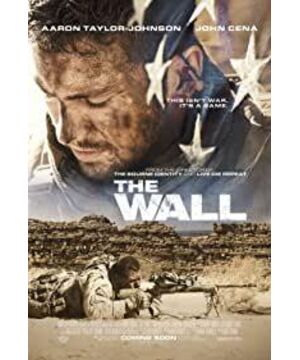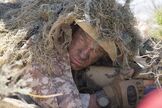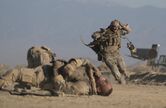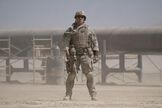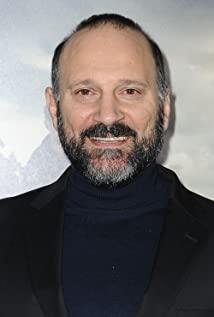Overall, The Wall of Life and Death is a pretty good sniper movie, and in my opinion, it can be roughly on a par with "Band of the City", "Sniper of Life and Death" and "American Sniper". But the biggest difference and feature from the above-mentioned films "The Wall of Life and Death" is the difference in the plot. In the sniper movies we usually see, our protagonists are the characters of "mantis catching cicadas and orioles behind", and they are often the ones who take the initiative on the battlefield. Or superb sniping skills and survivability to turn defeat into victory.
But "Wall of Life and Death" shows us a new angle. When the invincible American soldier we are familiar with in Hollywood movies is ambushed by an Iraqi sniper who is skilled in the hot desert, his teammates are shot and wounded. The ground could not be raised, the radio station was broken, the water bottle was leaked, the bullet in the right leg was bleeding, and after being forced into a low wall that could collapse at any time, there was no chance to fight back. became prey. In this case, can our protagonists turn their backs around like in other movies? It is this problem in the movie that attracts the audience to keep watching, and makes up for the fact that although "Wall of Life and Death" is a war movie, the scene is not grand enough, there is no exciting explosion, there is no cool fighting action, the scene is single, the rhythm Slow and so many shortcomings.
Also making up for these deficiencies are the exchanges between U.S. observers and Iraqi snipers. In the exchange between the two sides, the director let us see his understanding of the war and the impact of the war on the United States. For example: During the conversation, the US military observer told the Iraqi sniper that the war was over, but the Iraqi sniper asked: "The war is over, so why are you still here?" Another example: In the movie, the Iraqi sniper speaks fluent English, Using NATO's standard bullets and American guns, you may also have received formal American sniper training, and even use the American radio stations obtained from the battlefield to lure the US military to dispatch again and again, so as to "encircle the point and fight for reinforcements" to kill more people. many U.S. troops.
At the same time, it is rare for this movie to let American soldiers fall into passive for a long time, and let the "enemy" perform a role reversal. Finally, the American soldiers will be stupid (the American observers are played many times in the movie), the bullets will be inaccurate, and the enemy will not be deceived by simple tricks. This is one of the novelties of this film. "Jurassic World" said: "For canaries, cats are monsters. We're just too used to being cats." This movie finally made American GI become a canary.
In addition to the above three points, I think the twists and turns of the plot and the Iraqi sniper who only appeared in the play from the "scope point of view" (which is why I said that "Wall of Life and Death" is a horror-style sniper movie, the real protagonist It didn't appear from beginning to end), and I think that's what makes The Wall of Life and Death so interesting.
First of all, let’s talk about the twists and turns of the plot. After the observer was forced into the wall, there were several motives for the plot to flip, for example: the first counterattack of the sniper, the sound from the observer’s individual radio station, the single station of the mercenary security The appearance of the sniper, the second counterattack of the sniper, and so on. But it was accompanied by a dash of hope in the near future. Personally, I think the plot of "hope first and then shattered" is slower than the plot of "direct despair", but it can convey a stronger sense of despair to the audience.
Then I said that the Iraqi sniper that has never appeared, I think it is often not the "known", but the "unknown" that can bring people's spiritual fear. Only things of unknown origin and state can bring fear (this is why people and people are naturally afraid of the dark, because you can't see anything in the dark, and even in a familiar environment, you are often unable to determine what is in front of you). This "Wall of Life and Death" did a good job. During the entire film screening process, the audience, like the trapped observers, did not see the Iraqi sniper's appearance, and could only hear his voice. The only difference is that The audience can occasionally see the Iraqi sniper's "scope point of view", which also enhances the audience's sense of immersion in the film's plot. Especially at the end: two rescue helicopters in the Iraqi sniper's scope have been double-tapped by the Iraqi sniper, and the radio again recalled the voice of the Iraqi sniper disguised as a helicopter pilot reporting back to the base. The audience can't help but think deeply. I think this way of shooting is also similar to some European and American thriller or horror films, such as "Dark Invasion" and "Apollo 18".
At the same time, "Wall of Life and Death" also uses a "single scene" that is not common in war movies for performance and shooting. I think this is similar to the soft sci-fi movie "This Man From Earth". On the one hand, because there are fewer scenes, the crew is spared the need to travel around the world, and it also saves the trouble of going back and forth for sets, which reduces the cost of filming (The Man From Earth’s production cost is only $20,000, and The Wall of Life and Death "The production cost is also at a lower level among war films); on the other hand, unlike other thrilling war war films, which are bombarded with fire, the soldiers fight in various environments, giving the audience a strong visual and Aural stimulation, but then followed by a rapid forgetting, just finished watching it (popcorn movie), and even the cause of the beginning of the end has been forgotten. On the other hand, the singleness of the scene can increase the audience's impression of the whole movie, and also make the whole movie more intriguing.
To sum up, "The Wall of Life and Death" is indeed a relatively fresh war movie and a good sniper movie. However, there are still some flaws in some military details (such as the radio is not encrypted, etc.). But why does the movie think so much about it? After all, the steel wire mattress in "Wolf Warrior II" can act as a fence armor.
Finally, everyone is welcome to pay attention to my personal public account "Fanyan Aerial Photography", which contains some of my aerial photography works, and will also post film reviews from time to time
View more about The Wall reviews


